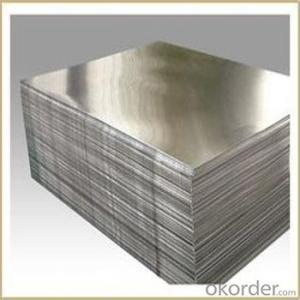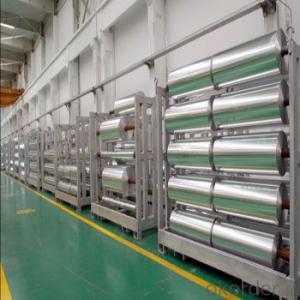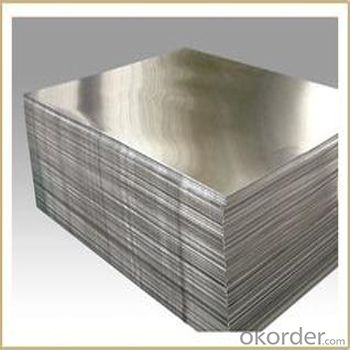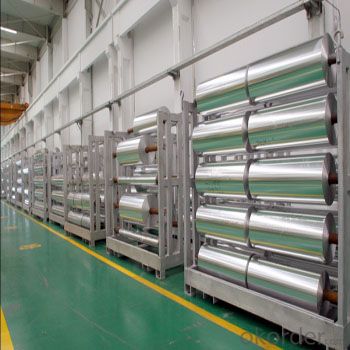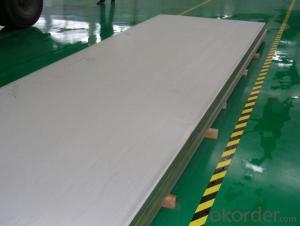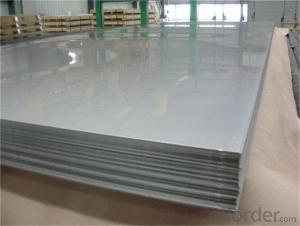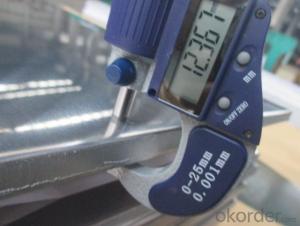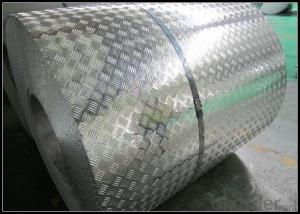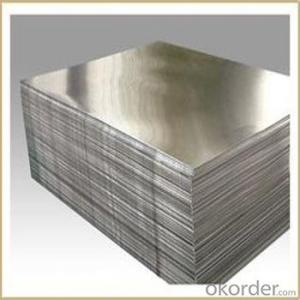Cricut Cut Embossed Aluminum Sheets - Coated Aluminum Sheets Supplier
- Loading Port:
- Shanghai
- Payment Terms:
- TT or LC
- Min Order Qty:
- 5 m.t.
- Supply Capability:
- 500 m.t./month
OKorder Service Pledge
OKorder Financial Service
You Might Also Like
1.Description
Aluminium foils thicker than 25 µm (1 mil) are impermeable to oxygen and water. Foils thinner than this become slightly permeable due to minute pinholes caused by the production process.
Aluminium foil has a shiny side and a matte side. The shiny side is produced when the aluminium is rolled during the final pass. It is difficult to produce rollers with a gap fine enough to cope with the foil gauge, therefore, for the final pass, two sheets are rolled at the same time, doubling the thickness of the gauge at entry to the rollers. When the sheets are later separated, the inside surface is dull, and the outside surface is shiny. This difference in the finish has led to the perception that favouring a side has an effect when cooking. While many believe that the different properties keep heat out when wrapped with the shiny finish facing out, and keep heat in with the shiny finish facing inwards, the actual difference is imperceptible without instrumentation. Foil may have a non-stick coating on only one side.The reflectivity of bright aluminium foil is 88% while dull embossed foil is about 80%.
2.Application and Detailed
EMBOSSED ALUMINIUM SHEET EMBOSSED ALUMINIUM SHEETS ALUMINIUM SHEETS
ALLOY : AA1***(AA1050,AA1060,AA1070,AA1100etc)
AA3***(AA3003,AA3004,AA3005,AA3105etc)
AA5***(AA5052 etc)
TEMPER:H14,H18,H24,H26,H32
THICKNESS:0.2mm-20mm
WIDTH:10mm-1500mm
EMBOSSED PATTERNS : Diamond, stucoo,bars etc
STANDARD: GB/T3880-2006
Special specification is available on customer's requirement
Coated Aluminium Sheet
ALLOY: AA1***(AA1050,AA1060,AA1070,AA1100etc)
AA3***(AA3003, AA3004,AA3005, AA3105etc)
AA5***(AA5052,AA5083,AA5754 etc)
TEMPER: H14,H16,H18,H22,H24,H26,H32,O/F
THICKNESS: O.O3mm-3.0mm
WIDTH: 30mm-1700mm
COATING: PE(POLYESTER),PVDF,EPOXY
PAINTING THICKNESS: STANDARD 16-25 MIC, MAX 40 MIC
COLOR: ACCORDING TO RAL COLORS OR CUSTOMER'S SAMPLES
STANDARD: GB/T 17748-1999
Special specification is available on customer's requirement
3.Our advantage
True factury, Best quality and Good reputation!
4.Pictures
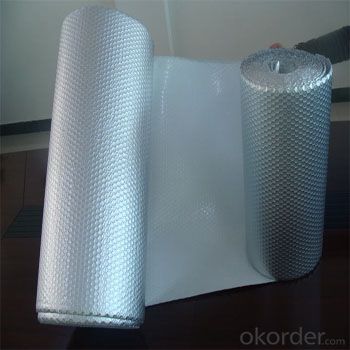
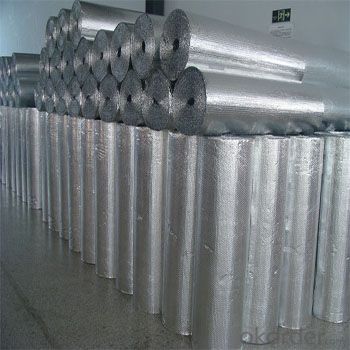
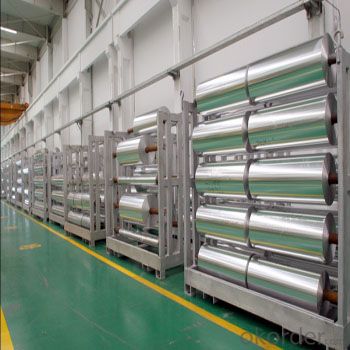
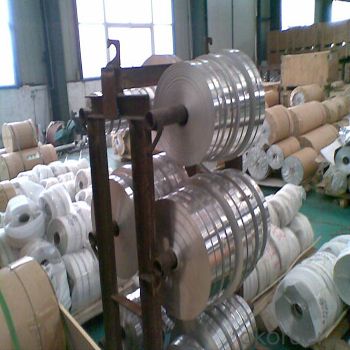
5.FAQ
1)How about our payment term?
LC and TT and other.
2)Which country can we supply?
All around the world!
- Q: What are the different methods of surface treatment for aluminum sheets?
- Aluminum sheets can undergo various surface treatment methods, each with its own purpose and desired outcome. Popular methods include anodizing, chromate conversion coating, painting, and powder coating. Anodizing is commonly used to enhance the corrosion resistance and durability of aluminum sheets. This involves immersing the sheets in an electrolytic bath and applying an electric current to create a controlled oxide layer on the surface. The result is a protective and decorative coating that can be colored or sealed. Chromate conversion coating, also known as chemical conversion coating or chromating, applies a thin layer of chromate to the aluminum sheets. This method provides excellent corrosion resistance and improves paint adhesion. The coatings can be clear or have a yellowish or iridescent appearance. Painting is a widely used method to protect aluminum sheets and improve their visual appeal. Sheets are typically pre-treated with a primer to enhance adhesion, followed by the application of a topcoat for protection and color. Painted aluminum sheets come in a wide range of colors and finishes, suitable for various applications. Powder coating is an environmentally friendly and durable surface treatment for aluminum sheets. It involves electrostatically applying a dry powder onto the sheets, which is then cured in an oven. The powder melts and fuses to form a tough and attractive coating. Powder coating offers excellent resistance to corrosion, chemicals, and UV radiation. In addition to these methods, other techniques like polishing, buffing, and mechanical finishes can be employed to achieve specific desired appearances or surface qualities. Ultimately, the choice of surface treatment method for aluminum sheets depends on factors such as desired corrosion resistance, aesthetic requirements, environmental considerations, and the intended application of the sheets.
- Q: How does the surface treatment of aluminum sheet affect its appearance?
- The surface treatment of aluminum sheet greatly affects its appearance. Aluminum, in its natural state, has a shiny and reflective surface that can be enhanced or altered through various surface treatments. One common surface treatment for aluminum sheet is anodizing. Anodizing involves creating a protective oxide layer on the surface of the aluminum through an electrochemical process. This treatment can produce a wide range of colors and finishes, from vibrant and opaque to translucent and metallic. Anodized aluminum sheets can have a sleek, modern appearance and are commonly used in architectural and decorative applications. Another surface treatment option is painting or powder coating. These processes involve applying a layer of paint or powder to the aluminum sheet's surface. This treatment allows for customization in terms of color, texture, and finish. Painted or powder-coated aluminum sheets can have a smooth, glossy appearance or a textured, matte finish depending on the desired outcome. This treatment is commonly used in industries such as automotive, aerospace, and construction where aesthetics and durability are important. Further, aluminum sheets can undergo mechanical surface treatments such as brushing or polishing. Brushing involves creating parallel lines on the surface of the sheet using abrasive pads, resulting in a brushed or satin finish. This treatment can give aluminum sheets a contemporary, industrial look. Polishing, on the other hand, involves buffing the surface to a high gloss, mirror-like finish. This treatment is often used for decorative purposes, such as in the production of jewelry or household items. Overall, the surface treatment of aluminum sheet plays a crucial role in determining its appearance. Whether it is anodizing, painting, powder coating, brushing, or polishing, each treatment offers a unique visual effect that can enhance the aesthetic appeal of the aluminum sheet for specific applications and industries.
- Q: hi my house is wired with aluminum wire and we have this light that has been changed 6 times because originally there was a cheap builders light up there that got replaced with a ceiling fan but the ceiling fan was replaced a couple of times since the remote never worked properly on any of the cieling fans so finally we replaced the cieling fan with just a normal light but now the socket got cracked on the new light by accident. The problem is im wondering if it is safe to put another light up because i have heard aluminum wire breaks easy and the wires have been moved around alot. But if i dont replace the light i wont have a light. We also use the correct wire nuts and anti oxidant on the connections. Also when the 4 cieling fans that had been put up were wired correctly since i have put up many cieling fans up without remotes before. Also Is there a certain number of times aluminum or copper wire can be bent with out having to worry about a fire happening or the wire breaking.
- Hardwood Refinishing low as $1per square foot #2 Common Red Oak Low as $4.45 per square foot, and finished! Brazilian Cherry starting at $7.95 per square foot, and finished (all sizes!) 608-728-2378
- Q: What are the different methods of surface cleaning for aluminum sheets?
- There are several methods of surface cleaning for aluminum sheets, each with its own advantages and suitability for different types of cleaning needs. 1. Mechanical Cleaning: This method involves using mechanical abrasion techniques to remove dirt, stains, and oxidation from the surface of aluminum sheets. It can be done using brushes, abrasive pads, sandpaper, or a wire brush. Mechanical cleaning is effective for removing heavy dirt or oxidation, but it may leave scratches on the surface if not done carefully. 2. Chemical Cleaning: Chemical cleaning involves the use of specific cleaning agents or solutions that are designed to dissolve or remove dirt, grease, oil, or other contaminants from aluminum surfaces. These cleaning agents can vary depending on the type of dirt or stain being removed. For example, alkaline cleaners are effective for removing oil and grease, while acidic cleaners can remove mineral deposits or oxidation. It is important to follow the manufacturer's instructions and safety precautions when using chemical cleaners. 3. High-Pressure Water Cleaning: This method utilizes a high-pressure water jet to clean the aluminum surface. The force of the water helps to dislodge dirt or grime from the sheet. High-pressure water cleaning is particularly useful for removing loose debris or light dirt from larger areas. However, it may not be suitable for heavily soiled or oxidized surfaces. 4. Steam Cleaning: Steam cleaning involves using high-temperature steam to remove dirt, grime, or other contaminants from aluminum sheets. The steam helps to loosen the dirt, making it easier to wipe or rinse away. Steam cleaning is effective for removing grease, oil, or other stubborn stains. It is a versatile method that can be used on both small and large surfaces. 5. Electrolytic Cleaning: Electrolytic cleaning is a specialized method that uses an electric current to remove contaminants from the aluminum surface. The aluminum sheet is immersed in a cleaning solution, and an electric current is passed through it. This causes the contaminants to be attracted to a sacrificial electrode, leaving the aluminum sheet clean. Electrolytic cleaning is effective for removing heavy oxidation or corrosion, but it requires specialized equipment and expertise. It is important to consider the specific cleaning requirements, the condition of the aluminum sheet, and the desired level of cleanliness when choosing the appropriate method of surface cleaning. It is also advisable to test the chosen method on a small, inconspicuous area first to ensure compatibility and avoid any potential damage to the aluminum sheet.
- Q: you can turn in aluminum cans for cash some are called golden goats
- Aluminum okorder
- Q: I have a problem when machining aluminium in my machine shop. There are times when the machines aluminium surface turns yellowish (somtimes brown). I do not know what is the main cause of the problem. Is it due to the coolant used?
- Aluminum oxides may appear in different colors depending on hydration states and other variables. Look in a CRC Handbook of Chemistry Physics if available for aluminum compounds and their colors. The colors that you see may also have as much to do with the surface finish as the color of the material on the surface. A microscopically rough surface will appear dark next to a polished surface due to light scattering. I will agree with Ling in principle, but not on details. EDS detection limits on homogeneous samples can be better than 0.1%, although not so good for elements at the light end of the detection range. Current detectors can detect chlorine (a common culprit for aluminum discoloration) at about 0.1%. Your problem with detection and one that Ling has addressed previously may be that a thin film of contamination would not be easily detected by EDS. As Ling suggests, SIMS is a good technique for detecting thin films and low concentrations. The problem with SIMS in this case may be that the detection limits are too good and the technique cannot be quantified. SIMS would detect 2 ppm of chloride and you couldn't tell for sure whether it was 2 ppm, which is probably not an issue here, or 2000 ppm, which would be significant. I would suggest x-ray photoelectron spectroscopy (ESCA or XPS) as an alternative for further study. The technique will analyze thin films (20 A) and detection limits are good enough (about 0.1%). In addition, XPS will give you information about the compounds present, e.g. whether the oxygen is aluminum oxide, aluminum hydroxide, etc. Good Luck.
- Q: Can the aluminum sheets be used for packaging applications?
- Packaging applications can indeed utilize aluminum sheets. As a versatile material, aluminum offers numerous advantages for packaging purposes. Its lightweight nature, coupled with its strength and durability, makes it perfect for safeguarding and maintaining a wide range of products, such as food, beverages, pharmaceuticals, and cosmetics. The malleability of aluminum sheets allows for easy customization, enabling tailored packaging solutions. Moreover, aluminum possesses exceptional barrier properties, effectively shielding packaged goods from moisture, oxygen, light, and other contaminants. Consequently, the shelf life of the products is prolonged. In addition, aluminum is an environmentally friendly choice for packaging applications due to its recyclability. Overall, the packaging industry extensively employs aluminum sheets due to their versatility, strength, durability, barrier properties, and recyclability.
- Q: Are aluminum sheets suitable for use in electrical applications?
- Yes, aluminum sheets are suitable for use in electrical applications. Aluminum has excellent conductivity and is lightweight, making it an ideal choice for electrical conductors, wiring, and components. Additionally, aluminum sheets offer good thermal conductivity and corrosion resistance, making them reliable and durable in various electrical environments.
- Q: Is there any reason to believe flushing aluminum foil down the toilet is a bad idea?
- sure ,the problems not the material thats not going to rot or move after it hits a bend in the sewer pipe or the plastic pipe in the wall ,its the stuff that will refuse to go down the pipe thats got a drag spot with the foil in the bend stopping the crap,, if you did this buy some plumbers acid at the home depot store and wear gloves and pour it down that drain and leave for a while then flush once wait then see if it comes back into the bowl, if not wait a little more then reflush
- Q: i keep hearing all these things about burning aluminum foil and such
- Yes, aluminum is a soft metal andit will not hold up well in a fire and if it's a hot fire you don't want to breathe in any fumes the rim might give off. If you want to use a rim, best to use steel. Or like the other guy said, rocks or bricks.
Send your message to us
Cricut Cut Embossed Aluminum Sheets - Coated Aluminum Sheets Supplier
- Loading Port:
- Shanghai
- Payment Terms:
- TT or LC
- Min Order Qty:
- 5 m.t.
- Supply Capability:
- 500 m.t./month
OKorder Service Pledge
OKorder Financial Service
Similar products
Hot products
Hot Searches
Related keywords
